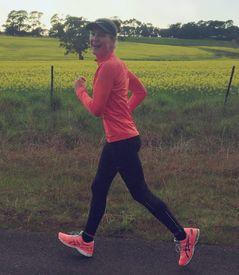It's HARD to run slowly! Footstrike/balance problems.

drbeanie2000
Posts: 81 Member
I find it extremely awkward and difficult to "run" slowly.
C25K and other programs say "Don't take it too fast! If you can run any slower, you're not running slowly enough!" But to me "running slowly" means almost "running in place" as far as footstrike. I end up doing mincing toe-strike steps and that makes me feel very wobbly.
But also, "running" at 4 mph for 30 seconds the other day on a treadmill shot my HR up to 170, a few bpm lower than my supposed "max" HR.
I guess I need to get cardio some other way before running/jogging, maybe some balance exercises too. I had plenty of those in PT from a high ankle sprain several years ago!
C25K and other programs say "Don't take it too fast! If you can run any slower, you're not running slowly enough!" But to me "running slowly" means almost "running in place" as far as footstrike. I end up doing mincing toe-strike steps and that makes me feel very wobbly.
But also, "running" at 4 mph for 30 seconds the other day on a treadmill shot my HR up to 170, a few bpm lower than my supposed "max" HR.
I guess I need to get cardio some other way before running/jogging, maybe some balance exercises too. I had plenty of those in PT from a high ankle sprain several years ago!
0
Replies
-
Try running in place until it's comfortable.. seriously. If that feels wobbly, take your shoes off and do it.
Post an update. 0
0 -
Are you trying to run on your toes as opposed to your natural gait?0
-
My slow run is more like a "shuffle" than a run.
Are you running exclusively on a treadmil? Can you try running on the ground instead?1 -
I think you are encountering the main drawback of a treadmill, which is that the speed is set arbitrarily. You may be exhausting yourself doing lots of tiny steps-- meaning that your cadence is too high. In outdoor running this is a very rare occurrence (it's usually too low so I understand).
When I started C25K, I did it on a track. My running style was all over the place at first. I tried longer and shorter strides, heel and toe strike, varying cadence, until I fell into a style that worked for me. I later read that you need to find your own stride and not do anything particularly unnatural for you. (This seems to be particularly true for heel vs. toe striking.)
There are only a few pieces of advice that I got from reading Fitzgerald's books: 1) Develop your own natural stride within reason, 2) Run upright, don't lean forward, 3) Higher cadence/shorter stride is more efficient for long distance running. 4) Establish distance (endurance) first, work on speed later.1 -
Running slowly means being able to talk (or sing) while you run. Ignore the heart rate. If you can sing, you are doing it right.
FWIW - Forget the formulas to find your max heart rate. They are often wrong (they are based on averages). The only way to know for sure is to be tested. Again, I suggest ignoring heart rate. Just run and sing. 2
2 -
This is interesting article on running. I don’t know if it will help you.
https://www.theverge.com/2017/7/30/16055332/running-stride-biomechanics-energy-expenditure0 -
You don't mention how far along in the program you are or how long you've been running. It takes awhile for your body to accustom itself to running.
When I was doing C25K, my goal was to finish the running intervals successfully. That meant adjusting my treadmill speed to accomodate how I was feeling. When I started to pant hard, I slowed down but kept running. The speed was not a factor. When I recovered and could breathe more freely, I slowly ramped the speed up a little bit.
As time went on, my body got stronger and I adjusted the speed less frequently, but still adjusted it as required.
4mph is 6.43 kilometers per hour. That is fast. If I remember correctly, I was running about 5Km/hour (about 3.1mph) when I was training and adjusting lower when panting or a bit higher when I started feeling stronger. My first 5k distance was run at 6Km/hr and that was at the end of the c25K program.
Perhaps 4mph is too fast for you?
You have to find your own comfortable pace. Not too tiny of steps; not too long. Experiment until you find your comfort zone.
Dewd2 uses the same technique that I used/use: if you can speak a short sentence while running without panting and puffing, you are at a good speed. If you are panting/puffing, you're going too fast.
Keep trying to find your pace. Once you've done that, you'll progress, get stronger and quicker.0 -
Honestly, I think you need to take the "slowly" with a grain of salt and realize that "slow" is different for everyone. Find where you're comfortable and able to complete the task. I have a very difficult time (treadmill or outside/track) trying to slow down my natural pace (which is a 8:30-9:30 minute mile when I've been training). It is more work for me to run slower than that, it sucks and I feel like I'm dying. Your cadence and stride length are going to be different on a treadmill than they are on the ground and it's a lot of work to get the pace right on the treadmill but it can be done just pay close attention and change up your speed on the treadmill as you need so you're not running off the front or falling down the back. Once you find your "sweet spot" all will be well.
How are you measuring your HR? If you're using the treadmill for that it won't be very accurate. As others have said, ignore your heart rate and go by the exertion you're feeling. As you go through the program it will get easier and you may see that reflect in your HR. Keep it up, one day at a time. If you can, try running outside, you may find it easier to get your pace down.0 -
This discussion has been closed.
Categories
- All Categories
- 1.4M Health, Wellness and Goals
- 398.1K Introduce Yourself
- 44.7K Getting Started
- 261K Health and Weight Loss
- 176.4K Food and Nutrition
- 47.7K Recipes
- 233K Fitness and Exercise
- 462 Sleep, Mindfulness and Overall Wellness
- 6.5K Goal: Maintaining Weight
- 8.7K Goal: Gaining Weight and Body Building
- 153.5K Motivation and Support
- 8.4K Challenges
- 1.4K Debate Club
- 96.5K Chit-Chat
- 2.6K Fun and Games
- 4.8K MyFitnessPal Information
- 12 News and Announcements
- 21 MyFitnessPal Academy
- 1.5K Feature Suggestions and Ideas
- 3.2K MyFitnessPal Tech Support Questions







